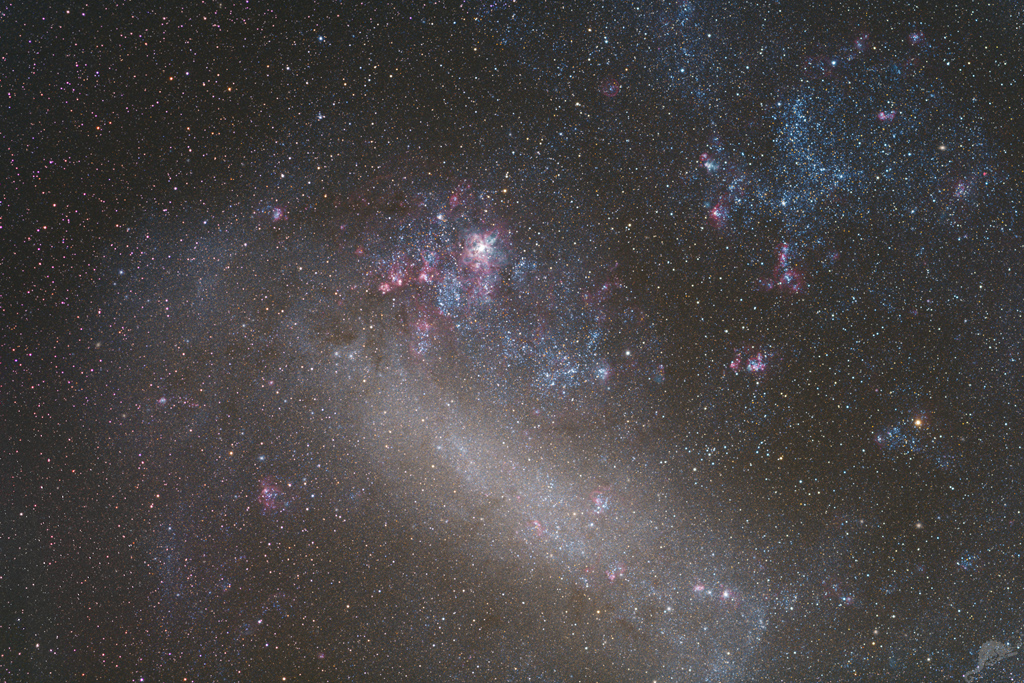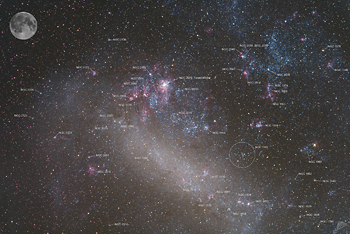 |
CHAMÄLEON + ONJALA OBSERVATORY DeepSky | SITEMAP HOME CHAMÄLEON |
|
 |
|||
| « back to overview Galaxies | Load higher resolution (1800 x 1200 Pixel 3500 x 2300 Pixel) | Object description |

The Large Magellanic Cloud (LMC) is located in our immediate galactic neighbourhood, only about 163,000 light years away from Earth. Together with the Small Magellanic Cloud (SMC) it is one of the closest dwarf satellite galaxies to our Milky Way. With a size of about 14 000 light years, it contains about 15 billion stars and is classified as an irregular galaxy type SBm because of its irregular structure, which shows a prominent bar towards the centre.
Because of its proximity, the Large Magellanic Cloud can be partially resolved into individual stars with large telescopes. It contains - like our Milky Way - a variety of objects such as open and globular star clusters, as well as luminous gas and dust clouds and H-II regions.
Especially in the central bar of the large Magellanic Cloud there are a large number of star clusters. There are about a dozen globular clusters as well as some 100 open star clusters known. Many of them have their own NGC numbers and were already discovered by John Herschel when he was on the southern hemisphere of Earth.
The star clusters in the large Magellanic Cloud are of different ages. However, the younger ones predominate and this suggests that star formation was initially small, but later a widespread and strong stellar evolution occurred. There is evidence that the Large Magellanic Cloud collided with a smaller galaxy a very long time ago, which then triggered an increased star formation rate.
Besides the many open star clusters, there is a special class of globular clusters, the so-called blue globular clusters. While the stars in the globular clusters of our Milky Way are generally very old (> 10 billion years), the globular clusters in the Large Magellanic Cloud consist of many blue stars of spectral class O and B, which are not older than a few hundred million years.
The show-piece of the large Magellanic Cloud is the Tarantula Nebula, also known as NGC 2070 or 30 Doradus. It is a very large gas cloud with a diameter of over 3000 light years. Neither in our Milky Way nor in any other galaxy of the Local Group is there a comparable H-II region. In the center of the Tarantula nebula is a large young stellar cluster with a diameter of 130 light-years, also called NGC 2070. The inner core region is called RMC 136a. Originally seen as a huge single star, it could be resolved into several components with the Hubble Space Telescope. One of these components, the star R136a1, with 265 times the mass of the Sun, is the most massive single star that has been observed so far.
In total, the star cluster contains about 1500 stars of spectral class B with masses between five and 20 solar masses, 400 stars of spectral class O with more than 20 solar masses and 17 Wolf Rayet stars.
For thousands of years the Magellanic Clouds have fascinated people in the southern hemisphere of the Earth, whereas they were largely unknown to Europe until the 16th century. The name we use today goes back to Ferdinand Magellan, who began the first circumnavigation of the earth 500 years ago.
 |
« The large
Magellanic Cloud in size comparison to the moon with object annotations. .Click here or on the preview image to load a large
image. A higher resolution image of the Tarantula Nebula with further description to RMC 136a is shown here A high resolution image of the central star cluster of the Tarantula Nebula from us is shown here Images of the Small Magellanic Cloud from us here and a widefield view here Further links: High resolution image of the ESO with annotation of object can be found at the following URL: https://www.eso.org/public/images/eso1021d/ High resolution image of the ESO of RMC 136a can be found at the following URL: https://www.eso.org/public/unitedkingdom/news/eso1030/?lang |
 |
 |
 |
 |
 |
 |
 |
| Sun | Moon | Solar System | DeepSky | Widefield | Miscellaneous | Spec. Projects |